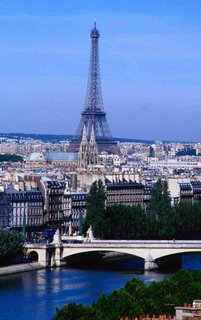
The Eiffel Tower and the River Seine
Long considered the paragon of style, Paris is the most glamorous city in Europe. It is at once deeply traditional – a village-like metropolis whose inhabitants continue to be notorious for their hauteur – and famously cosmopolitan. While such contradictions and contrasts may be the reality of any city, they are the makings of Paris: consider the tiny lanes and alleyways of the Quartier Latin or Montmartre against the monumental vistas from the Louvre to La Défense; the multiplicity of street markets and old-fashioned pedestrian arcades against the giant underground commercial complexes of Montparnasse and Les Halles; or the aristocratic wealth of the grand quarters against the vibrant chaos of the poorer districts.
At times, Paris can feel inhumanly magnificent, the arrogance of its monuments encompassing the chilly pomp of the Panthéon, the industrial chic of the Eiffel Tower and the almost spiritual glasswork of the Louvre pyramid. Yet it also operates on a very human scale, with exquisite, secretive little nooks tucked away from the Grands Boulevards and very definite little communities revolving around games of boules and the local boulangerie and café. And even as Paris's culture is transformed by its large immigrant and gay populations, even as extravagant new buildings are commissioned and erected, many of the city's streets, cafés and restaurants remain remarkably, defiantly unchanged.
In the great local tradition of the flâneur, or thoughtful boulevard-stroller, Paris is a wonderful city for aimless wandering. Relaxed quarters such as the vibrant Marais, elegant St-Germain and romantic Montmartre are ideal for street-browsing, shopping and café-sitting, and the city's lack of open space is redeemed by beautiful formal gardens, by the pathways and pavements that run beside the River Seine, and by endless hidden or unexpected havens. And everywhere you go, historic landmark buildings and contemporary architectural wonders remind you of the city's pride and grandeur – and stop you getting lost.
There are over 150 art galleries and museums in the city – few of them duds – and an uncounted number of cafés, brasseries and restaurants lining every street and boulevard. The variety of style and decor is hard to beat, ranging from ultra-modern fashion temples to traditional, mirrored palaces, and from tiny bistrots where the emphasis is all on the cooking to bustling Vietnamese diners. After dark, the city's theatres and concert halls host inventive and world-leading productions of theatre and dance, while many classical concerts take place in fine architectural settings, particularly chapels and churches. Above all, Paris is a real cinema capital, and the city's vibrant cultural mix puts it at the forefront of the world music scene.
Information by Rough Guides
Няма коментари:
Публикуване на коментар